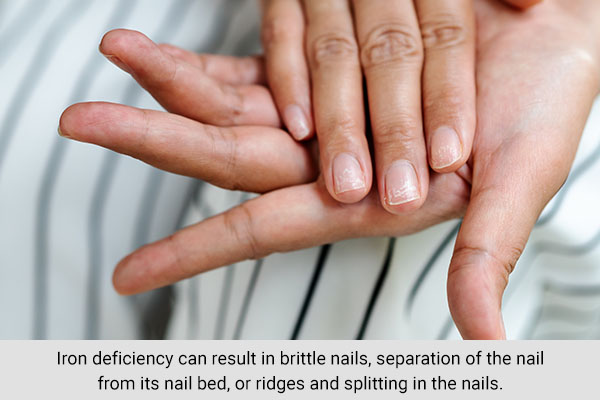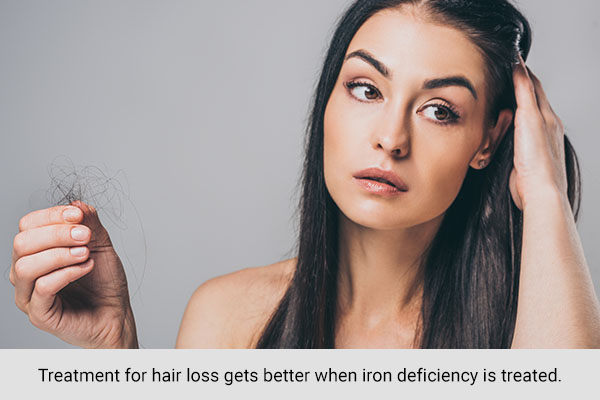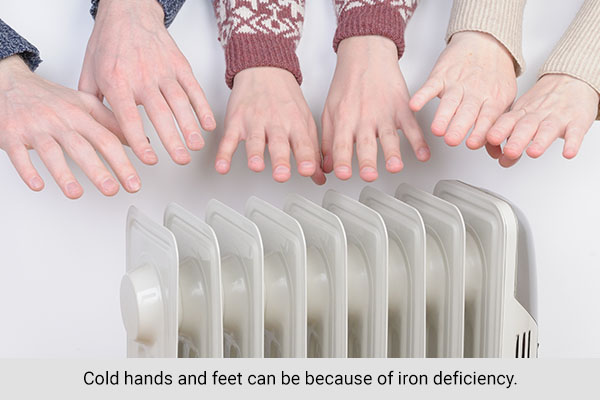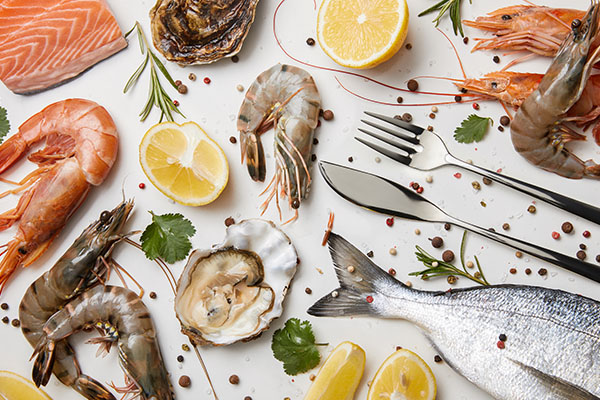In this article:
Proper intake of iron, which is an important dietary mineral, is extremely important in the maintenance of body functions.

The most essential use of iron is in the production of hemoglobin in the body. Hemoglobin is a protein responsible for the proper delivery of oxygen throughout the body via red blood cells.
Not only this, but iron is important as a transport medium for electrons to travel in the body. Iron is also required by various enzymes to perform specific functions.
Therefore, maintaining a sufficient level of iron in the body is a must for healthy functioning. (1)
Signs and Symptoms of Iron Deficiency
The signs and symptoms of iron deficiency can include the following.
1. Skin hyperpigmentation
Research has indicated that hyperpigmentation and melasma can ensue from iron deficiency anemia.
Melasma is a skin disorder that causes skin patches and spots darker than your natural skin color. It can negatively impact your appearance, causing psychological problems such as low self-esteem in some people.
According to a study, low iron levels in women with melasma point towards a possible link between iron deficiency and melanoma or hyperpigmentation.
Evidence, therefore, implies that hyperpigmentation can happen as a consequence of iron deficiency as patients with melasma have been documented to have insufficient serum levels of hemoglobin and iron. (2)
2. Brittle nails

The nails are a window to inner nutritional levels. Many nutritional deficiencies manifest on the nails, but it can be tricky to catch any kind of nutritional deficiency just by monitoring nail changes. Magnesium, calcium, iron, zinc, sodium, and copper are all important for nail health.
Pallor of the nail bed can be an indication of iron deficiency anemia and a clue that body levels of iron may be insufficient. Koilonychia, a condition where your nails get soft and have a spoon-shaped imprint is believed to ensue from iron-deficiency anemia too.
Research also reports that iron deficiency can result in brittle nails, separation of the nail from its nail bed, or ridges and splitting in the nails. (3)
3. Fatigue
In one study, women who suffered from low iron levels reported lower physical and mental energy when compared to women with no history of iron deficiency. They experienced a state of “constant tiredness,” suggesting that iron deficiency can be linked with decreased health and well-being and increased fatigue. (4)
Another research examined the effects of iron supplementation and a high-iron diet on fatigue in iron-deficit women. The interventions led to improvements in mental activity, showing that treatment of iron deficiency with either supplementation or a high-iron diet decreased fatigue among the subjects. (5)
The same result was shown by another study from the Canadian Medical Association Journal, where the effect of oral iron therapy on fatigue was studied. The study deduced that patients who received iron supplements showed improvements in their fatigue scores. (6)
4. Unpleasant sensation in the legs/feet

Over the last couple of years, researchers have spent a lot of time and resources on understanding restless legs syndrome. Various types of research have shown that the brain concentration of iron is an important factor in this disease.
Research revealed that treatment of iron deficiency led to improvement of symptoms associated with restless legs syndrome. Data have shown patients who suffer from restless legs syndrome have lower levels of the iron storage protein called ferritin. This confirms the role of iron insufficiency as a cause of restless legs syndrome. (7)
5. Psychiatric disorders
Studies that examined the link between psychiatric disorders (for example feeling sad all the time, confused thinking, excessive worries, and excessive guilt) and iron deficiency found that people diagnosed with iron deficiency anemia have an increased risk of psychiatric disorders.
One study also concluded that iron deficiency increased the risk of: (8)
- Mood disorders
- Autism spectrum disorder
- Attention-deficit hyperactivity disorder
- Developmental disorders
6. Hair loss

Several studies have evaluated the relationship between iron deficiency and hair loss, suggesting iron deficiency to be related to alopecia and diffuse hair loss, although other studies do not support this claim.
However, according to the Cleveland Clinic Foundation, treatment for hair loss gets better when iron deficiency is treated. (9) Another study revealed that women who are iron deficient are at risk of hair loss. The same study also underlined the role of serum ferritin in hair loss. (10)
7. Pica (craving for nonfood substances)
Pica is a condition where a person craves nonfood substances. This unusual craving for non-nutritive substances can cause various health risks.
According to a study, pica is an important sign of iron deficiency and should not be taken for granted. Several hypotheses are available that explain how iron deficiency causes pica, but none have been proven yet. (11)
One study found that pica behavior in pregnant adolescents was linked with significantly lower iron status during pregnancy. The study concluded how iron deficiency is related to pica, even though the etiology is unknown. (12)
8. Menstrual migraine
A study was done with the aim to determine the prevalence and characteristics of patients with menstrual migraine. It concluded that women who suffered from iron deficiency had increased incidents of menstrual migraine. (13)
Findings of another study also found that iron deficiency anemia was commonly observed in patients with menstrual migraine and thus can be associated with it. (14)
9. Cold sensitivity

Cold hands and feet can be because of iron deficiency. This can be explained by the fact that people with iron deficit don’t get enough oxygen supply to their tissues. (15)
According to animal studies, iron-deficient rats become hypothermic or sensitive to cold due to a drop in thyroid hormone (T3). Treatment of iron-deficient animals with iron normalized the plasma thyroid response, showcasing a link between them. The proposed hypothesis shares that iron deficiency can hinder the conversion of thyroid hormones T4 to T3, leading to the hypothermia observed. (16)
10. Tongue abnormalities
Research has shown that extended suffering from anemia can lead to:
- Weakening or degeneration of tongue papillae
- Burning or painful tongue (glossal pain)
- Difficulty swallowing (dysphagia)
In one study, patients with iron deficiency and those with anemia have a history of tongue pain, although patients with anemia have more painful regions on the tongue than patients with only iron deficiency.
After being treated with oral iron supplementation, many of the patients, within 2 months, showed a rise in serum ferritin levels, pain threshold levels, and salivation. They also exhibited a reduction in glossal pain.
It is, therefore, safe to say that iron deficiency causes glossal pain and the level of glossal pain increases as the iron deficiency progresses to anemia, leading to hyposalivation and abnormalities of glossal papillae. (17)
Recommended Dietary Allowance (RDA) for Iron
- The recommended dietary allowance (RDA) for all age groups of men and postmenopausal women is 8 mg/day.
- The RDA for premenopausal women is 18 mg/day.
- The RDA for pregnant women is 27 mg/day.
- The tolerable upper intake level for adults is 45 mg/day of iron. (18)(19)
Having lower levels of iron in the body than required can lead to health problems and is known as iron deficiency. Sadly, iron deficiency stands to be one of the most common nutritional deficiencies.
Causes of Iron Deficiency
The various possible causes of iron deficiency are as follows: (20)
- The major percentage of iron is present in RBCs, so excessive bleeding can cause iron deficiency. It is, in fact, the most common cause of iron deficiency in evolved countries. Bleeding can be due to hematemesis, menorrhagia, multiple pregnancies, gastrointestinal bleeding, or childbirth.
- Parasitic infections such as hookworm infection
- Increased frequency of blood donations, especially in women
- Poor financial backgrounds
- Vegetarian or vegan diet
- In kids, excessive milk intake or extended bottle feeding
- Decreased absorption of iron due to conditions such as celiac disease, gastritis, and Helicobacter pylori infection or due to dietary components such as phosphates, oxalates, and calcium
- Intake of drugs that can hinder proper iron absorption such as antibiotics, levodopa, and levothyroxine
- Chronic disorders such as kidney disease, heart failure, inflammatory bowel disease, and rheumatoid arthritis
How to Get Sufficient Iron Through the Diet

There are two forms of dietary iron. The first one is heme iron, which is seen in animal sources, and the other one is nonheme iron, which is taken from plant-based foods.
Heme iron is more easily absorbed by the body than nonheme iron. (20)(21)
To increase your iron intake, consume iron-rich foods.
Heme iron is found in:
- Veal
- Pork
- Lamb
- Chicken
- Turkey
- Fish
- Seafood
Nonheme iron (especially ferric salts) is most commonly found in:
- Legumes
- Corn
- Wheat
- Barley
- Rice
- Pasta
- Bread
- Cooked spinach
- Nuts
- Seeds
- Dry fruits
- Dairy products
Complications of Untreated Iron Deficiency
If left untreated, iron deficiency can lead to substantial cognitive impairment and inferior quality of life.
During pregnancy, untreated iron deficiency can have a negative impact on the baby’s brain maturation. It can also lead to decreased birth weight. The new mother can be prone to depression, increased risk of sepsis, and maternal mortality if she is iron deficient.
In patients with heart failure, untreated iron deficiency exhibits a link with an increased mortality rate. (20)
Most-Asked Questions About Iron Deficiency
What foods provide iron?

You can get the recommended amounts of iron by eating the following:
- Seafood
- Poultry
- Iron-fortified breakfast cereals
- Spinach
- Kidney
- Raisins
- Dried fruits
- Lentils
Who are at risk for iron deficiency?
The following groups of people are more likely than others to have trouble getting enough iron:
- Menstruating women
- Infants (especially if they’re premature)
- Blood donors
- Patients with cancer
- Pregnant women
- Patients with heart ailments
Can too much iron be harmful?
Yes, iron can be harmful if you take too much supplementation. Large amounts of iron may cause:
- Nausea
- Constipation
- Stomach pain
- Vomiting
- Inflammation of the stomach lining
- Ulcers
- Decreased zinc absorption
Taking very high doses of iron can lead to:
- Organ failure
- Coma
- Convulsions
- Death
Final Word
Iron is a dietary mineral that your body needs for proper growth and development. It is required for a ton of functions in the body, including the production of various hormones.
The amount of iron you need each day depends on your age, gender, and lifestyle. Insufficient iron levels in the body can cause iron deficiency, which if left untreated can cause anemia. Looking out for signs and symptoms that signal iron deficiency is important to avoid complications.
- Was this article helpful?
- YES, THANKS!NOT REALLY


